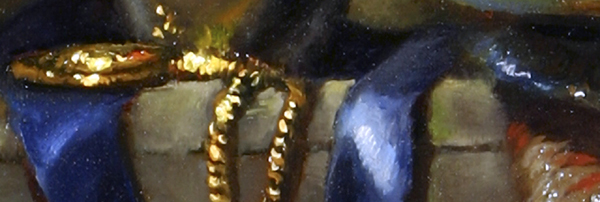 A very faithful reader of this blog brought to my attention that I have not included any information about painting #6. I promised to write a post describing this painting which actually was completed several weeks ago.
A very faithful reader of this blog brought to my attention that I have not included any information about painting #6. I promised to write a post describing this painting which actually was completed several weeks ago.
Shown here is a very small detail of my completed painting based on the Rembrandt and the Golden Age of Dutch Art Exhibit painting/palette by Adriaen van der Werff.
The Dutch Exhibit painting, on page 25 of the catalogue, is by Adriaen van der Werff and measures 31 3/4 by 25 3/4. Self Portrait with the Portrait of his Wife Margaretha van Rees and their Daughter has components which clearly portray the artist’s reputation within the art world of his time, 1659-1722.
Van der Werff was enormously famous, enjoyed international success, and became very wealthy with his painting prowess. He was appointed court painter to Elector Palatine’s court in Dusseldorf in 1697. For this honor he received the gold chain and medal shown around his neck in his painting.
This exhibit painting could be described as a “painting within a painting” and shows the artist with brush and palette. Another interesting twist is the portrayal of the daughter as an artist holding a brush and palette just finishing a portrait of her mother.
As I have stated many times, the color of the catalogue images often do not depict the actual true colors of the Rembrandt and the Golden Age of Dutch Art Exhibit paintings. This one falls into that category and shows an overall yellowish gold that is off. Therefore, everything is either too reddish or too orangish. So while I was painting this one, I had to constantly look at my notes and adjust the color accordingly.
There is a blue ribbon surrounding the girl and the mother that shows as very dark gray/blue in the catalogue. In the true museum painting the ribbon actually is a rich glowing lapis blue. I incorporated a blue ribbon into the composition of my painting and used very vibrant tones of pure lapis pigment as it is shown in the true van der Werff piece. The sleeve of the artist’s gold colored cloak is shown much too orange which I kept in mind while painting the objects on my canvas also.
Again and again while working on this project, I struggle between a balance of staying true to each Dutch Master palette and straying to other colors which might fit my particular color sense. It takes a lot of discipline during each day of painting with frequent self-talk, “stay on track….remember the purpose…remember the project.” When I do this it is very helpful and calming. The concept is reinforced. The concept is COLOR….its all about the color….its all about the pigment.

Wow! That lapis blue ribbon really pops off the canvas. I can’t wait to see the rest of the painting.
I agree – the little clip would make a wonderful rich abstract!
Hello, Margret. I just discovered your blog (I attended Alyson Stanfield’s workshop yesterday where she mentioned you to the audience). I, too, am inspired by the works of the Renaissance Masters and use many of their methods. When I was working on a copy of Vermeer’s “Girl with a Pear Earing” I was surprised by how different the colors looked from poster prints compared to photos in art books and other various reproductions. Seeing these paintings (old masters) in person is so important to truly appreciating the work and the methods. I’m so glad I saw the Rembrandt exhibit in Dayton last year.
Patrice Erickson
Fine Art Portraits and Landscapes